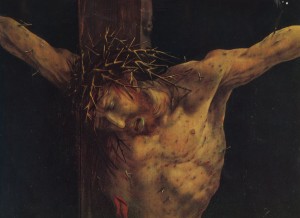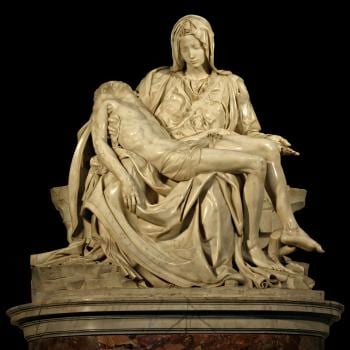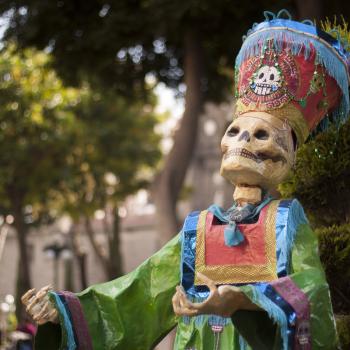 “What I don’t understand” said my friend, “is how you think the criminal’s death of one man two thousand years ago has anything to do with you, or me or anybody living here and now.”
“What I don’t understand” said my friend, “is how you think the criminal’s death of one man two thousand years ago has anything to do with you, or me or anybody living here and now.”
At first it seems like a sensible enough question. We see billboards saying “Christ died for you.” or we hear slogans like, “Jesus died to save you from your sins.” For the ordinary person on the street in individualistic, relativistic twenty first century America what on earth do such religious phrases mean? What can they mean?
The first thing to try to explain is the idea that “no man is an island.” We’re all linked. We belong to a common human race with a common history. This shouldn’t be too hard to understand–even the most isolated person belongs to a family or a club or a group of some kind. Neither should it be impossible for people to see how the death of one person of great importance could impact many people–or indeed the whole human race. Who was not affected in some way, for example, by the assassination of John F. Kennedy?
But of course there is more to it than this. Jesus Christ is more than a martyr for a cause or a victim of a tragic killing, and this is where it is necessary to first of all understand and accept who Jesus Christ really is. An understanding and appreciation of his death and its effects are dependent on an understanding and appreciation of who he really is. This is why the apostles and the fathers of the church very early on preached the gospel that Jesus of Nazareth was the Son of God. It is because he is God incarnate that his death matters so much. It is because he is Son of God that he is also the universal man, and that is why his death and resurrection has an effect on me.
A discussion, therefore of the atonement must begin with a discussion of the incarnation. Jesus Christ was God from God, Light from Light, True God from True God. Taking human flesh from Mary his mother, he became obedient unto death, even death on the cross. He is therefore the second Adam–the Man who represents mankind–the One who holds All within himself. Without accepting this primary fact of revelation there is no adequate explanation for the Christian doctrines of the atonement.
With this primary fact of revelation the Christian doctrines of the atonement and the various “theories” which explain the atonement all begin to make sense. How then, does one begin to explain such astounding beliefs to those we wish to evangelize? It is very difficult because in our society so many have been inoculated against full blooded Christianity by the watered down modernist version they have been taught. The incarnation is downplayed by the modernists. People have been taught that Jesus was “a Son of God” or that he was a good teacher or a radical prophet or a freedom fighter or an All American Alpha Achiever or whatever. If that is all he is, then his death is merely the death of an inspiring martyr, and worthy and admirable though it may be, it does not really explain how we can say that “he died for the sins of the whole world.”
We should not be surprised, therefore, to find that the version of the death of Christ which is now taught from many modernist pulpits is just that–that Jesus’ death was an inspiring martyrdom. The most we might get is the idea that Jesus is my friend and that he died for me, but my doubting friend will come back with the retort that this is a load of sentimental crap which makes no sense and his original question still stands–“How on earth can you say that a guy who died two thousand years ago died for you? He didn’t your life isn’t in danger. You aren’t about to die on a cross and he steps in to take your place.”
This is why, along with the crucifixes in church we could do with a few more magnificent images of Christ the King and Judge Eternal. This is where the iconography of the church becomes important for it teaches a lesson. On or above the altar is the Christ Crucified–above is something like this:  When we remember the King of Glory was also the Man of Sorrows and we understand that the King of Glory is the Universal Man the Second Adam we can then understand what the death of Christ really means.
When we remember the King of Glory was also the Man of Sorrows and we understand that the King of Glory is the Universal Man the Second Adam we can then understand what the death of Christ really means.
Finally, this understanding is not simply intellectual. We are not simply giving assent to a doctrinal proposition or theological explanation. We are also giving emotional and spiritual assent.
We accept not only the idea of his death, but the death itself. A transaction takes place. We open ourselves to its reality and open our hearts to its truth for if Christ is the Universal Man then he is truly part of me and I of him, and so his death does in deed touch me and I can say with all my heart and mind and soul, “Jesus died to save me from my sins and I accept him as my personal Lord and Savior.”
When we, even once, even in a faltering way, take this step we take a huge leap forward into an new kind of existence and a new dimension of reality.
UPDATE: This post on Sacred Page gives some scholarly info to complement my post.











